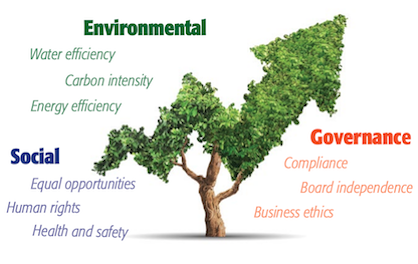Early adopters have shown profitable results with value in top-line growth.
ESG and the energy transition have been at the forefront of company announcements—new partnerships, investments and decarbonization strategies—throughout the first half of 2021. The evolution of moving from announcements to detailed plans with measurable results is driving new scoring standards and streamlined processes for data collection to adequately measure results and progress. There is heightened investor scrutiny on greenwashing and ensuring investment decisions are made considering the spectrum of comparative metrics from the qualitative impact of investments.
Early ESG adopters are proving profitable results with value in top-line growth, reduction in costs, minimized regulatory interventions and optimized investments and capex. ESG’s impact on the fundamentals of equity valuation is demonstrating support for the relationship between ESG and financial performance.
Investors of capital are assessing fundamental questions such as, “Does the enterprise have a business model that faces threats from climate change and regulation? Are its social practices and policies optimized to attract and retain customers and human capital? Is its governance such that it can sustain unforeseen challenges?”
Hart Energy’s Energy ESG conference in March brought in 2,452 attendees to discuss these issues. Three major themes have emerged since that event. Companies with robust ESG programs are benefitting from reduced cost through lower cost of capital, growth and long-term profitability and attracting and retaining a stronger workforce.
Cost of capital
Evidence is building that there is a positive relationship between ESG measures and corporate financial performance. Energy is no longer a zero-sum game, and recognizing the change doesn’t mean anyone is better than those who have done it the past 100 years.
Sustainable practices not only look at what profits a company generates but also how it generates them. This involves a fundamental shift in how companies are viewed and valued.
ESG provides a structure to identify and quantify future liabilities through forecast and adjustments or scenario analysis. Scenario analyses enable investors to translate potential risks into financial cost and identify these risks and opportunities, allowing man- agers to calculate the impact-adjusted profits and real potential profitability.
Companies with high ESG scores have reported access to a lower cost of capital for both equity and debt as integrating ESG criteria into portfolios has become a mainstream focus for investors and financial partners. Investments less susceptible to systematic market risks receive higher valuations in a discounted cash flow model.
ESG-scored companies have also reported ESG-lined corporate lending, when lenders have tied the terms of lending to the achievement of specified ESG criteria by corporate borrowers, an innovative model to the traditional lending underwriting terms.
While the cost-of-capital link to ESG performance is a more recent market trend, more explicit criteria for financing is emerging as investors, lenders and companies improve their understanding of how management of ESG risks can translate into long-term financial performance.
Growth, scale and profitability
Companies leaning in and embracing growth in their principles and measures are not only earning the trust and loyalty of stakeholders but also proving to be more sustainable, driving long- term, profitable growth. They are more likely to retain customers and scale in new areas of business.
Across the value chain in the energy businesses, companies are seeking partners that align on priorities of decarbonization and responsible sourcing with strong ESG practices like investing in alternative energy, reducing fugitive methane emissions and setting goals for greenhouse-gas emissions. Customer ESG commitments and aligning with partners is more important now that customers are becoming more self-sufficient. Technologies are enabling traditional customers to self-generate power, procure products and market more independently and potentially more competitively than ever before.
Resilient, stronger workforce
Human capital remains one of the most significant costs of doing business and is directly linked to productivity, innovation and business success. A company’s ESG performance on workforce sentiment can be a competitive advantage. Because a substantial portion of many companies’ intangible economic value is embodied in their people, boards are spending more time on human capital governance and oversight to manage risks. Investors know there are substantial potential risks associated with human capital including attracting and retaining talent, turnover, productivity, innovation, customer relationships and compliance as well as diversity, equity and inclusion.
Human capital is crucial to the performance of producing better results across the organization, and enthusiastic prospective employees strengthen a company’s talent pipeline. By 2029, the millennial and Gen Z generations will make up 72% of the world’s workforce, compared to 52% in 2019. These generations place greater importance on ESG concerns than their predecessors and will expect more from employers on these issues.
“ESG’s impact on the fundamentals of equity valuation is demonstrating support for the relationship between ESG and financial performance.” – Emily Easley, NOVUS Energy Advisors
With the future of energy supply and demand so uncertain, it is foreseeable that some combination of the speculated trends will occur. By leaning in and accelerating adaptations for ESG reporting processes, companies leading the way have the opportunity to set the standards for the baselines and practical goals for a sustainable energy transition.
See original article published on Hart Energy here.



